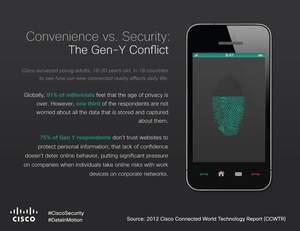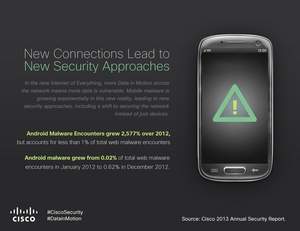LONDON--(Marketwire - Jan 30, 2013) - CISCO LIVE -- Cisco (
Despite popular assumptions that security risks increase as a person's online activity becomes shadier, findings from Cisco's 2013 Annual Security Report (ASR) reveal that the highest concentration of online security threats do not target pornography, pharmaceutical or gambling sites as much as they do legitimate destinations visited by mass audiences, such as major search engines, retail sites and social media outlets. In fact, Cisco found that online shopping sites are 21 times as likely, and search engines are 27 times as likely, to deliver malicious content than a counterfeit software site. Viewing online advertisements? Advertisements are 182 as times likely to deliver malicious content than pornography.
Security risks rise in businesses because many employees adopt "my way" work lifestyles in which their devices, work and online behavior mix with their personal lives virtually anywhere -- in the office, at home and everywhere in between. The business security implications of this "consumerization" trend are magnified by a second set of findings from the Cisco Connected World Technology Report (CCWTR), which provides insight into the attitudes of the world's next generation of workers, Generation Y. According to the study, most Generation Y employees believe the age of privacy is over (91%), but one third say that they are not worried about all the data that is stored and captured about them. They are willing to sacrifice personal information for socialization online. In fact, more Generation Y workers globally said they feel more comfortable sharing personal information with retail sites than with their own employers' IT departments -- departments that are paid to protect employee identities and devices.
As Generation Y graduates from college and enters the workforce in greater numbers, they test corporate cultures and policies with expectations of social media freedom, device choice, and mobile lifestyles that the generations before them never demanded. As the first chapter of the Connected World Technology Report indicated in December, Gen Y is constantly checking social media, email and text updates, whether it's in bed (3 of 4 surveyed globally), at the dinner table (almost half), in the bathroom (1 of 3), or driving (1 of 5). That lifestyle is entering work environments in greater numbers, spotlighting the future of work and how companies must consider competing for the next wave of talent. Unfortunately, what the security studies show is the next-generation workforce's lifestyles are also introducing security challenges that companies have never had to address on this scale.
Key Findings
Android Malware
- Android malware encounters grew 2,577 percent over 2012. (ASR)
- However, mobile malware represents only 0.5 percent of total Web malware encounters. (ASR)
- These trends become especially significant considering the smartphone is the No.1 device among Gen Y workers over laptops, PCs and tablets (CCWTR)
Web Malware Encounters by Country
In 2012, there was significant change in the global landscape of where users encountered Web malware. China dropped from being the second-most malware-stricken country in 2011 to the sixth spot last year. Scandinavian countries, such as Denmark and Sweden, experienced greater numbers of Web malware encounters, climbing the world ranking to the third and fourth spots, respectively. The United States retained the top spot with 33 percent of the world's Web malware encounters. (ASR)
| 1. United States | 33.14% | |
| 2. Russian Federation | 9.79% | |
| 3. Denmark | 9.55% | |
| 4. Sweden | 9.27% | |
| 5. Germany | 6.11% | |
| 6. China | 5.65% | |
| 7. United Kingdom | 4.07% | |
| 8. Turkey | 2.63% | |
| 9. Netherlands | 2.27% | |
| 10. Ireland | 1.95% |
Spam Trends
- Spam volume dropped 18 percent from 2011 to 2012, with spammers working "banker's hours" for a 25 percent drop in spam over the weekend. (ASR)
- In 2012, the majority of spam was sent during the workweek -- Tuesday was the heaviest spam day of the year. (ASR)
- India is the top source of spam worldwide, with the U.S. moving from sixth in 2011 to second in 2012. Korea, China and Vietnam round out the top five. (ASR)
- The top spoofed brands involve prescription drugs like Viagra and Cialis and luxury watches like Rolex and Omega. (ASR)
- Spammers maximize the ROI of their efforts, targeting real-world events with specific and short-lived campaigns. (ASR)
- January-March: Windows software, which coincided with the release of the Microsoft Windows 8 consumer preview.
- February-April: Tax software during U.S. tax season.
- January-March and September-December: Professional networks like LinkedIn, correlated with the desire for a career change during the beginning and end of the year.
- September-November: Cellular providers around the release of the Apple iPhone 5.
Privacy Tradeoff
Cisco considered the business implications of these and other threat statistics by examining the attitudes and behavior of always-on, on-demand Gen Y employees.
- Although most Gen Y respondents do not trust websites to protect personal information (75 percent), such as credit card and personal contact details, their lack of confidence does not deter their online behavior, gambling that they will not be compromised. This puts a large amount of pressure on companies when these individuals take risks online with work devices on corporate networks. (CCWTR)
- Fifty-seven percent of Gen Y is comfortable with their personal information being used by retailers, social media sites, and other online properties if they will benefit from the experience. (CCWTR)
IT Policy Compliance
- Nine of 10 (90 percent) IT professionals surveyed said they have a policy governing the use of certain devices at work, yet only two of five Gen Y respondents said they were aware of such a policy. (CCWTR)
- To make matters worse, four out of five Gen Y respondents who were aware of IT's policies said they do not obey those policies. (CCWTR)
- IT professionals know that many employees don't follow the rules, but they don't understand how prevalent it is: More than half (52 percent) of IT professionals globally believe their employees obey IT policies, but nearly 3 out of 4 (71 percent) of the Gen Y workforce say that they don't obey policies. (CCWTR)
- Two of three (66 percent) Gen Y respondents globally said IT has no right to monitor their online behavior, even if that behavior is conducted using company-issued devices on corporate networks. (CCWTR)
- The aversion to employer IT monitoring was greater than the aversion Gen Y respondents had to retail sites monitoring their online behavior. In other words, Gen Y is less averse to complete strangers at retail sites monitoring their activity than their own employers' IT teams -- teams that are there to protect them and their companies' information. (CCWTR)
The Internet of Everything & Security's Future
Looking ahead, the Internet of Everything represents the largest online trend today. As more people, things and devices connect to the Internet, more data from more places will be introduced across corporate and service provider networks, which open up new vulnerabilities and a need for more sophisticated security approaches.
- Exponentially more machine-to-machine (M2M) connections are coming online each day, leading to a proliferation of endpoints that extend far beyond mobile devices, laptops and desktops to an "any-to-any" scenario in which any device can connect to any cloud to any application across any network.
- By 2020, with an Internet open to an estimated 50 billion things, the number of connections balloons to more than 13 quadrillion (specifically, 13,311,666,640,184,600). Adding just one more "thing" (50 billion + 1) will increase the number of potential connections by another 50 billion.1
- These new connections generate data in motion that needs to be protected in real time as it is evaluated for actionable insights through the network and before it's compromised and causes irreparable damages.
- For network security professionals, the focus becomes content-neutral plumbing -- shifting from the endpoint and the periphery to the network.
Supporting Quote
- John N. Stewart, senior vice president, chief security officer, Global Government and Corporate Security, Cisco
"Each year, the security threats and defenses change as a result of one another. The Cisco Annual Security Report is our expert research, highlighting global threat patterns and trends. When combined with findings from the Cisco Connected World Technology Report and how the next-generation workforce views security, there are unique, troubling and informative correlations and conclusions. Today, we live a blended work-personal life. The hackers know this, and the security threats that we encounter online such as embedded Web malware while visiting popular destinations like search engines, retailers, social media sites and smartphone/tablet apps no longer threaten only the individual; they threaten our organizations by default. This year's ASR highlights this and other trends while providing the hard data, and ideas, for how we should be approaching security today."
About the Studies
The Cisco 2013 Annual Security Report highlights the most important security trends of the year and provides tips and guidance to keep enterprise technology environments more secure. The Cisco Connected World Technology Report magnifies the threats outlined in the security report.
The third annual Cisco Connected World Technology Report was commissioned by Cisco and conducted by InsightExpress, an independent market research firm based in the United States. The global study consists of two surveys: one focused on college students and young workers 18 to 30 years old, and the second focused on IT professionals across a range of industries globally. Each survey includes 100 respondents from each of 18 countries, resulting in a pool of 3,600 respondents. The 18 countries are the United States, Canada, Mexico, Brazil, Argentina, United Kingdom, France, Germany, Netherlands, Russia, Poland, Turkey, South Africa, India, China, Japan, South Korea and Australia.
SUPPORTING RESOURCES
- Read the Cisco 2013 Annual Security Report
- Visit website: Cisco Connected World Technology Report
- Read about the acquisition of Cognitive Security from Christopher Young, senior vice president of the Security and Government Group, Cisco
- View video: Cisco's John N. Stewart, senior vice president, chief security officer, Global Government and Corporate Security, on Information Security: Understanding a Global Picture in a Local Context
- For additional research on consumer shopping behavior read the January 14, 2013, Cisco press release: Eight Out of 10 Consumers Shop Through Bits and Bytes
- View video: Gen Y and Technology
- Learn about: The Internet of Everything
- Read Data in Motion insights
- Join the security conversation on Twitter by following @CiscoSecurity. You can like Cisco Security on Facebook at http://facebook.com/ciscosecurity
- Learn more: Cisco Platform Blog
- Read Cisco Blogs
About Cisco
Cisco (
Cisco and the Cisco logo are trademarks or registered trademarks of Cisco and/or its affiliates in the U.S. and other countries. A listing of Cisco's trademarks can be found at www.cisco.com/go/trademarks. Third-party trademarks mentioned are the property of their respective owners. The use of the word partner does not imply a partnership relationship between Cisco and any other company.
RSS Feed for Cisco: http://newsroom.cisco.com/rss-feeds
1 How the Internet of Everything Will Change the World... for the Better
http://blogs.cisco.com/news/how-the-internet-of-everything-will-change-the-worldfor-the-better-infographic/
Contact Information:
Press Relations:
David Oro
Cisco
707-558-8585
daoro@cisco.com
Analyst Relations:
Trevor Bratton
Cisco
949-823-1212
trbratto@cisco.com
Investor Relations Contact:
John Choi
Cisco
408-526-6651
johnchoi@cisco.com

